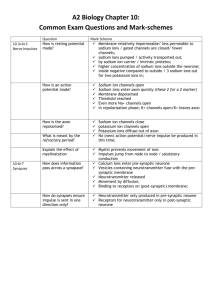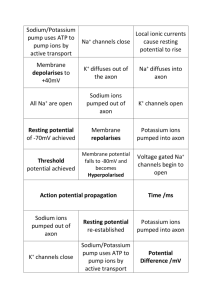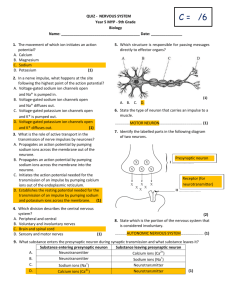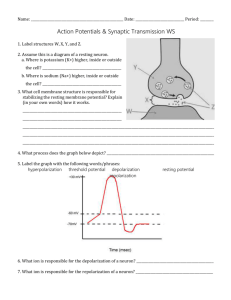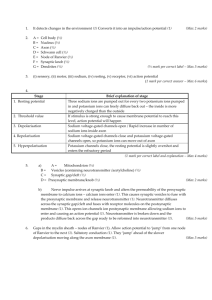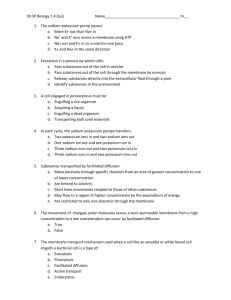Neuron Structure
advertisement
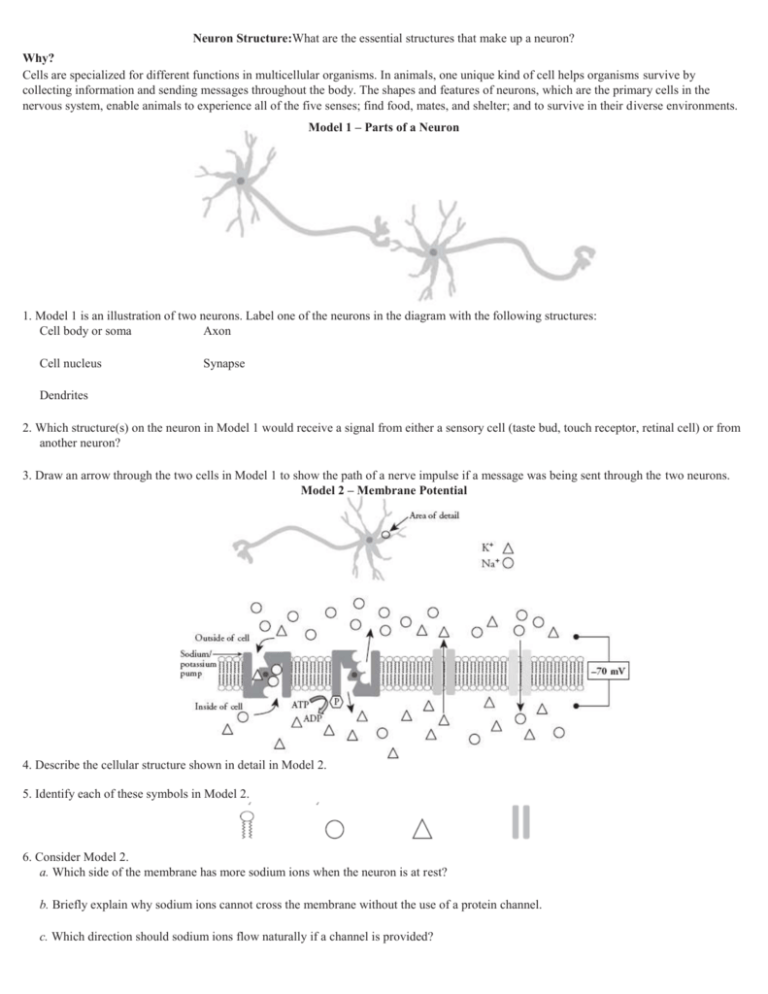
Neuron Structure:What are the essential structures that make up a neuron? Why? Cells are specialized for different functions in multicellular organisms. In animals, one unique kind of cell helps organisms survive by collecting information and sending messages throughout the body. The shapes and features of neurons, which are the primary cells in the nervous system, enable animals to experience all of the five senses; find food, mates, and shelter; and to survive in their diverse environments. Model 1 – Parts of a Neuron 1. Model 1 is an illustration of two neurons. Label one of the neurons in the diagram with the following structures: Cell body or soma Axon Cell nucleus Synapse Dendrites 2. Which structure(s) on the neuron in Model 1 would receive a signal from either a sensory cell (taste bud, touch receptor, retinal cell) or from another neuron? 3. Draw an arrow through the two cells in Model 1 to show the path of a nerve impulse if a message was being sent through the two neurons. Model 2 – Membrane Potential 4. Describe the cellular structure shown in detail in Model 2. 5. Identify each of these symbols in Model 2. 6. Consider Model 2. a. Which side of the membrane has more sodium ions when the neuron is at rest? b. Briefly explain why sodium ions cannot cross the membrane without the use of a protein channel. c. Which direction should sodium ions flow naturally if a channel is provided? 7. Consider Model 2. a. Which side of the membrane has more potassium ions when the neuron is at rest? b. Which direction should potassium ions flow naturally if a channel is provided? 8. The embedded proteins in Model 2 illustrate both active and passive transport. What evidence from Model 2 supports the idea that one of the types of embedded proteins use active transport? 9. Does the sodium/potassium ion pump move sodium ions into or out of the cell when activated? 10. Does the sodium/potassium ion pump move potassium ions into or out of the cell when activated? 11. What is the ratio of sodium ions to potassium ions that are moved through the sodium/potassium ion pump each cycle? 12. If the sodium/potassium ion pump were to stop functioning, what would eventually happen to the concentration gradients of sodium and potassium ions across the membrane? Justify your answer with evidence from Model 2. 13. The diagram in Model 2 shows a voltage or potential across the membrane. a. What is the resting membrane potential of a neuron? (Be sure to include units.) b. Propose an explanation for why there is an uneven distribution of charge across the membrane, resulting in a potential. Read This! When a neuron is “at rest,” it is constantly pumping sodium ions out and potassium ions in to maintain a potential across the membrane of about –70 millivolts. The outside of the neuron has a slightly positive charge, the inside a slightly negative charge. The potassium/sodium ion pump process must be continuous as the ions will “leak” back in or out in the direction of the concentration gradient. The resulting membrane potential is caused by a combination of factors including the relative number of positive and negative ions on each side of the membrane and the properties of the ion channels themselves. In this state the neuron is always ready to quickly respond to a stimulus. Model 3 – Membrane Potential Gradient 14. The protein channel illustrated in Model 3 is a ligand-gated channel. What must occur for the “gate” to open and allow movement of ions across the membrane? 15. Consider Model 3. a. What type of ions, sodium or potassium, are moving through the ligand-gated protein channel when it is open? b. Are the ions moving against the original concentration gradient or with the original concentration gradient? c. Is the transport of ions across the membrane active or passive transport? Justify your reasoning. 16. When the gated channel is open and ions flood through, does the concentration of that ion species inside of the cell increase, decrease or stay the same … a. in the immediate vicinity of the protein channel? b. in the area further away from the protein channel? 17. What will happen to the ions that entered the cell through the gated channel in the time that follows the closing of the channel? (Recall this is the same membrane that contains the embedded proteins from Model 2.) 18. Examine the voltage readings across the membrane in Model 3. How does the flood of ions through the gated channel affect the membrane potential … a. in the immediate vicinity of the protein channel? b. in the area further away from the protein channel? 19. What will happen to the membrane potential in the time that follows the closing of the channel? 20. The shapes of some proteins are dependent on the electrical potential in the surrounding area. Predict what might happen to such a protein if it was near one of the gated protein channels as it opened. 21. Extreme athletes use sports drinks not only to hydrate but also to replenish the electrolytes (ions) in their body that are lost through sweat. Propose some reasons why this would be necessary to keep an athlete healthy and in top condition. 22. How long is the longest neuron in the human body, and where is it located?
